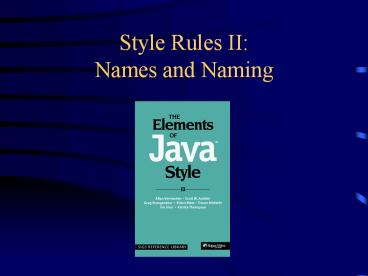Style Rules II: Names and Naming - PowerPoint PPT Presentation
1 / 17
Title:
Style Rules II: Names and Naming
Description:
Names should be chosen very carefully, to indicate the purpose of a ... If variables have no special meaning, you can use names that reflect their types ... – PowerPoint PPT presentation
Number of Views:99
Avg rating:3.0/5.0
Title: Style Rules II: Names and Naming
1
Style Rules IINames and Naming
2
Overview
- Today we will discuss
- Reasons for naming conventions
- Rules for naming variables, classes, and methods
3
Why have naming conventions?
- A program is written once, but read many times
- During debugging
- When adding to the program
- When updating the program
- When trying to understand the program
- Anything that makes a program more readable and
understandable saves lots of time, even in the
short run
4
Rule 9Use meaningful names
- Names should be chosen very carefully, to
indicate the purpose of a variable or method - If the purpose changes, the variable or method
should be renamed - It is worthwhile spending a little time choosing
the best name - Long, multiword names are common in Java
5
Rule 10 Use familiar names
- Where common terminology exists, use it dont
make up your own - Example from the book If your users refer to
customers, your program should use the name
Customer, not Client
6
Rule 11 Question excessively long names
- Variables should be used for a single purpose
- Methods should do one simple, clearly defined
thing - If a descriptive name is overly long, maybe the
variable or method is trying to serve too many
purposes
7
Meaningful names exceptions I
- It is common practice to use i as the index of a
for-loop, j as the index of an inner loop, and k
as the index of a third-level loop - This is almost always better than trying to come
up with a meaningful name - Example
- for (int i 1 i 1, j
" i j)
8
Meaningful names exceptions II
- Method variables may be given short, simple
names, IF - The purpose of the variable is obvious from
context, and - The variable is used only briefly, in a small
part of the program - But never use nonmeaningful names for class or
instance variables
9
Rule 28 Use standard names for throwaway
variables
- If variables have no special meaning, you can use
names that reflect their types - For example, if you are writing a general method
to work with any strings, you might name them
string1, string2, etc. - Alternatively, you can use very short names
- s, t, u, or s1, s2, etc. are often used for
Strings - p, q, r, s are often used for booleans
- w, x, y, z are often used for real numbers
10
Rule 12 Join the vowel generation
- Despite the cutesy name, this rule is important
- In more primitive languages, names were often
limited to 8 or so characters - This led to names like maxVolum and lngPlyng
- The usual rule was to leave out vowels, starting
from the right - Such names are harder to read and to remember
- Do not leave out vowels, or otherwise use unusual
abbreviations, in Java!
11
Naming classes
- Rule 18 Capitalize the first letter of each
word, including the first PrintStream,
Person, ExemptEmployee - Rule 19 Use nouns to name classes
ExemptEmployee, CustomerAccount - Classes are supposed to represent things
12
Naming variables
- Rule 25 Capitalize the first letter of each word
except the first total, maxValue - Rule 26 Use nouns to name variables
balance, outputLine - Variables are supposed to represent values
13
Naming methods
- Rule 22 Capitalize the first letter of each word
except the first display, displayImage - Methods are capitalized the same as variables
- Rule 23 Use verbs when naming methods
displayImage, computeBalance - Methods are supposed to do something
14
Rule 13 Capitalize only the first letter in
acronyms
- In names, write acronyms such as GUI and API as
Gui and Api - Examples setDstOffset, displayAsHtml,
loadXmlDocument - Since capital letters are used to separate names,
this rule helps avoid confusion
15
Naming constants
- A constant is an identifier whose value, once
given, cannot be changed - Constants are written with the keyword final, for
example - final int FIVE 5
- final float AVOGADROS_NUMBER 6.022E23
- Rule 31 Constants are written in ALL_CAPITALS,
with underscores between words - Exception color names, such as Color.pink
- Colors were defined before conventions were
established
16
Will you be held responsible for following these
rules?
- Yes
17
The End































